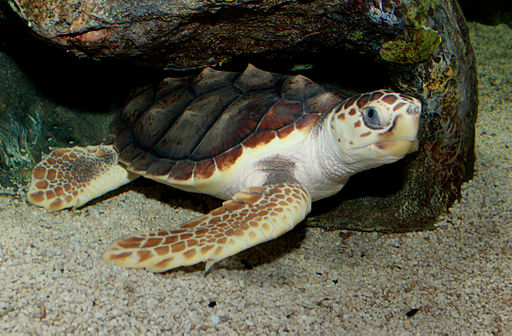The loggerhead sea turtle is a large turtle, whose scientific name is Caretta caretta.It is known as loggerhead turtle because her head is bigger than the rest of sea turtles
In the Canary Islands, it is the most common sea turtle, being present all year and becomes abundant in the spring and summer. Its population in the archipelago is mainly composed of juveniles and some adults.
Characteristics
The average size is 70 cm although the adult species can reach up to 120 cm in length and weight usually does not exceed 100 kg. It is a long-lived animal, with an average life expectancy of around 60 years being known cases of turtles that have reached 100 years. The dorsal area of its carapace is reddish-brown and whitish ventral area. It is an animal poikilothermic (cold-blooded) so your metabolic activity depends on the external or ambient temperature, being more active in summer and during the day.
A great traveler
It is a solitary animal that makes great voyages, being able to perform migrations of thousands of kilometers. In the Canary Islands, they found specimens that had previously been marked in the United States. Perform cyclic transoceanic journeys, aided by ocean currents, outward and return, which can last several years and believed to be in their long journeys, are guided by the Earth’s magnetic field, thanks to particles of iron oxide have in his head.
Distribution and habitat
It is found in tropical and subtropical waters of the Atlantic, Pacific and Indian oceans and the Mediterranean Sea. The Canary Islands, is an important feeding area and development for young specimens of this species from different American populations and Cape Verde. In the winter months they migrate to more tropical waters.
Food
Their diet is mainly carnivorous, their beak-shaped mouth and powerful jaws, they allow you to break the shells of mollusks, crustaceans, and other invertebrates. It also feeds on fish, jellyfish, squid, sponges, shrimp, sea urchins and fish eggs, and seaweed.
Reproduction
The loggerhead turtle curiously returns to spawn at the same place where he was born and reaches sexual maturity around 15-35 years. Reproductive rate is low because, although females perform an average of four set by season and each put a mean of 100 eggs … only nest every 2 or 3 years. The breeding season runs from May to September and usually nocturnal and egg incubation lasts between 55 and 69 days depending on the place where they were deposited. Hatching, it is also usually occurs at night as darkness decreases the chance of predation. Their places are preferred nesting on the beaches of Brazil and Florida (USA), although they have also been seen in Africa, Turkey and Cyprus. The Mediterranean population is much smaller than the Atlantic. As a curiosity, note that the incubation temperature determines the sex difference pups: If the nest temperature is 32°C or higher, raising almost counted likely be female; if the temperature is 28°C or lower, breeding be male and if the temperature is around 30°C, born about 60% females and males 40%.


